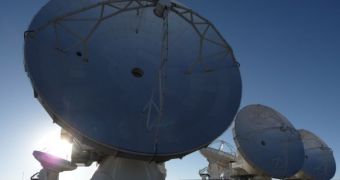Astronomers at the Harvard-Smithsonian Center for Astrophysics (CfA) praise the opening of the world's most advanced radio observatory for scientific studies. Though not yet completed, the Atacama Large Millimeter/submillimeter Array (ALMA) is already surpassing any other similar instrument.
At this point, only 22 of its planned 66 high-resolution antennas are online, but the international collaboration of researchers in charge of the project say that the entire installation will be finished on schedule, in 2013.
Perched about 16,500 feet (roughly 5,000 meters) above sea level, the observatory lies in the Chilean Andes, on the Chajnantor Plain of the Atacama Desert, the most arid place on Earth. At this point, ALMA is conducting what astronomers refer to as Early Science (ES) observations.
The reason why this telescope is so important is that it's the most complex and advanced tool for radio astronomy ever built, even in its current, unfinished form. It is capable of peering back in time to when the Universe was just a few million years old.
It can also identify objects that are too cold for even the most advanced infrared sensors to see. The secrets of the Universe may finally be revealed using this instrument, and this is why many research teams applied to have access to at least a few hours of observation using the instrument.
According to ALMA deputy director Lewis Ball, the limited ES observation time could only accommodate about 100 projects in all. “We were stunned when we received over nine hundred requests from all over the world!” the official says.
“No other telescope on ground or in space has ever had this magnitude of over-demand,” adds the expert, who also holds an appointment as the ALMA Chief of Staff at the National Radio Astronomy Observatory. The NRAO is one of the major international partners on the project.
CfA astronomer David Wilner's research project was one of the 100 to be selected for ES observation time. “My team hunts for the building blocks of solar systems, and ALMA is uniquely equipped to spot them,” the investigator says.
He explains that the target of his team study was the star AU Microscopii, which is located only 33 light-years away. The object is also very young, as astronomers established its age at no more than 50 million years. For comparison, the Sun is about 4.6 billion years old.
“We will use ALMA to image the 'birth ring' of planetesimals that we believe orbits this young star. Only with ALMA can we hope to discover clumps in these dusty asteroid belts, which can be the markers of unseen planets,” Wilner concludes.

 14 DAY TRIAL //
14 DAY TRIAL //